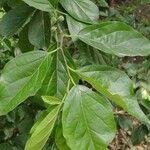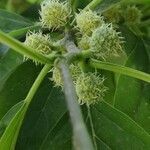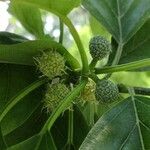A tree which loses its leaves seasonally. It grows up to 8 m high. It is a broad spreading tree. The bark is greyish brown. The young branches are slightly ridged. Young trees and branches have thorns but these fall off. They are 5-20 mm long. The leaves are carried one after another along the branch. The leaves are like mulberry leaves. Often leaves have three lobes with the central love the largest, but leaf shape can vary. The winter buds are reddish brown. Male and female flowers occur on different plants. Female trees are larger than male trees. The flowers are green and pea-sized. Male flowers are 0.5 cm across. Female flowers are 1-1.5 cm across. Pollen is carried by wind. Fruit are somewhat like a mulberry and litchi. The fruit are 1-2.5 cm across and orange-red when ripe. The flesh is juicy and red with 3-6 small brown seeds. In colder places the leaves drop before fruit are ripe. The fruit is edible.




